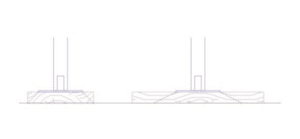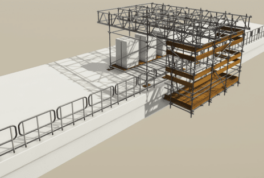What is Bearing Pressure?
What is Bearing Pressure?
Bearing pressure is simply a load (force) over a certain area. For instance, a 100 kg mass exerts a force of 1 kN.
- When this load is evenly applied over 1 square metre then we can say the pressure being applied by this force is: = 1kN / 1m2 = 1 kN/m2
- If this load were increased to say 5000 kg (5T) then the pressure applied = 50 / 1 = 50 kN/m2
- If the 50 kN were applied over an area 2m x 2m (4 sq. m) then the bearing pressure becomes: = 50 / 4 = 12.5 kN/m2.
The important point is whether the load can actually be evenly spread which is a function of the material doing the spreading and whether the ground can take the pressure being applied to it. Just because we put sole boards and spreader beams on the ground doesn’t mean they are spreading the load evenly over their entire area.
Demonstrating bearing pressure
To demonstrate, consider a bendy piece of thin plywood and a stiff steel road plate placed on a bed of springs with the same load applied centrally to each.

In this example we can see the pressure under the thin bendy plywood is not distributed evenly so you get a variable pressure with a peak in the middle and almost nothing at the edges – by contrast, the stiff steel spreads the load evenly and distributes the load into an even bearing pressure.
So what is happening with a scaffold standard?
Typically scaffold standards are loaded to 20-30 kN and if we consider them being on a base plate only we could calculate:
P = 20 / 0.15 x 0.15 = 888 kN/m2 (a very large bearing pressure, albeit over a small area).
So what happens when we introduce a 450mm long scaffold board Sole Plate?

Timber has different load-spreading properties in different directions – with or against the grain. So we have already calculated the bearing pressure between the base plate and the top of the sole plate but what is the pressure, after load spreading, between the soleplate and the ground?
To simplify this we typically adopt load spread proportions of 2:1 with the grain and 1:1 perpendicular to the grain. So first we calculate the effective area spreading load at the base of the soleplate after it has spread by these proportions:

Width = 38mm + 150mm + 38mm = 226 mm (Limited to 225mm board width)
Length = 38 + 38 + 150 + 38 +38 = 302 mm
Bearing Area = 0.225 x 0.302 = 0.068 m2
Bearing pressure under sole plate = 20 / 0.068 = 294 kN/m2
As you can see, by the application of a single sole board we have achieved a large reduction in the bearing pressure on the ground.
What happens when we use double-sole boards?

This time the load spread area =
Width = Same as before as it cannot spread wider = 225 mm
Length = 38 + 38 + 38 + 38 +150 + 38 + 38 + 38 + 38 + 38 = 454 mm
Bearing area = 0.225 x 0.454 = 0.102 m2
Bearing pressure under double boards = 20 / 0.102 = 196 kN/m2
This is an improvement but because we are only increasing the length and not width the benefits are limited.
What happens if we adopt a cruciform board sole plate?

Now we get load spread in both directions.
From the first board:
Width = 225 mm
Length = 302 mm
Now add on the distribution through the second layer of boards in both directions:
Width = 38 + 38 + 225 + 38 + 38 = 377 mm
Length = 38 + 302 + 38 = 378 mm
Bearing area under second layer of boards = 0.377 x 0.378 = 0.143 m2
Bearing pressure = 20 / 0.143 = 139.9 kN/m2
Now it’s really starting to drop off.
So what are the implications of this?
Well, if the ground is soft (grassed or tarmac) you will need to spread the load and reduce the pressures until they reach an allowable limit. Where we are basing out on concrete, for instance, you don’t need to spread the load.
The problem now becomes how to determine what pressure the ground can permit. I.E. How do you determine the Permissible or Allowable bearing pressure? This is normally determined by site investigation where physical tests are undertaken to determine how capable the ground is of supporting these loads. There are costs involved in doing this, but when it is known the ground is poor or soft and an overly conservative allowable pressure is adopted, the foundation improvement or weight-spreading solution can be very expensive.
Below are typical values for allowable bearing pressures for different materials:

Read more Technical Guidelines.








